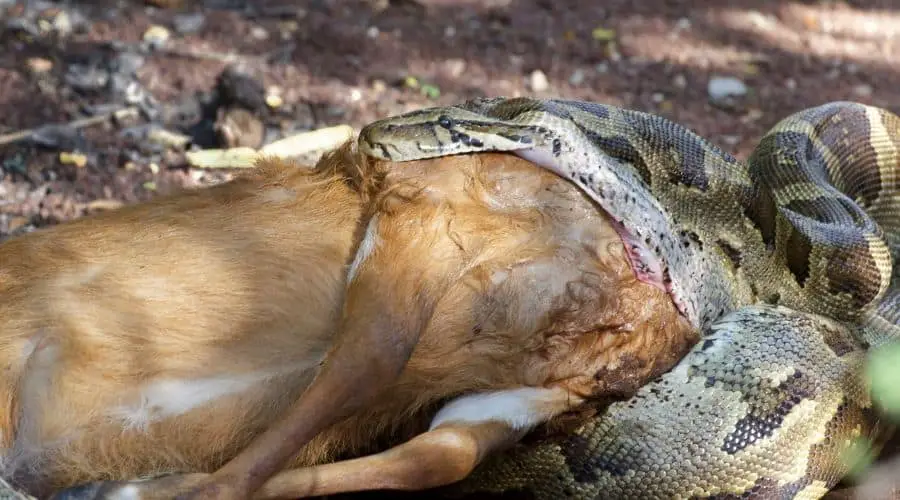Snakes don’t have any eyelids, which might contribute to their poor eyesight. However, they can see even if it’s not their keenest sense.
Meanwhile, a snake’s sense of smell is outstanding and many hundreds of times better than any humans owing to their Jacobson’s organ, which helps them ‘see’ scent.
They flick their tongues out to collect smells. What happens if a snake eats something too big?
If a snake attempts to swallow prey that is too big, it will normally spit it back out of its mouth. Since snakes are cold blooded, if the temperature outside isn’t warm enough, the snake could have trouble digesting the large prey fast enough which will cause the prey to slowly rot inside them and cause sickness or death.
Table of Contents
What If A Snake Eats Something Too Big
If a snake genuinely eats a prey item that is too big and doesn’t swallow properly, it will typically throw up. Getting the animal back out of its body is the only way to handle the problem.
Otherwise, anything that fits inside a snake is digestible, though bigger meals will take a lot longer to process.
In some cases, if the weather is too cool, the snake might not digest a large meal. Unfortunately for the snake, this has more to do with being cold-blooded than the size.
A snake that isn’t warm enough to run its body correctly can end up sick or dead as the animal it swallowed slowly rots inside it. It’s a dreadful and disgusting issue, but it’s also avoidable.
Can Snakes Hurt Themselves By Eating Something Too Big
A snake can’t hurt its jaw or throat by eating something too large. Unlike most animals, a snake’s lower jaw is two main parts connected by stretchy ligaments, and its ability to hinge open is much larger than its head.
Most of the time, if the food is too big and the snake can’t swallow, it pushes it back out, but there’s no particular indication that this is especially painful.
However, snakes do have nerve endings, so that they may be uncomfortable.
Can Snakes Choke To Death
Snakes can choke or suffocate if they eat something too large. However, this is not an extremely common occurrence.
Snakes eating long prey like other snakes are more likely to have this issue, and a snake can also eat a live animal without killing it, resulting in internal damages that kill the snake.
According to Lung.org, “Most snakes only have one functioning lung and do not require the exchange of respiratory gasses to live. They also breathe by contracting muscles between their ribs.”
If a meal stops a snake from contracting its breathing muscles, it may choke.
What Happens If A Corn Snake Eats Something Too Big
A corn snake can make a mistake like any animal. When choosing prey for your pet, it is essential to select the correct size to help prevent them from getting in over their heads.
Regrettably, a corn snake can overeat and pass away. Alternatively, a corn snake can end up constipated if the meal is too much to handle, which can quickly threaten their health and life. No pet owner wants a sick or dead snake.
Cornsnakes, in particular, have highly stretchy skin, even among snakes.
As a general rule, you should stick to prey items around your snake’s width at the thickest point, but corn snakes can handle food up to one point five times their width.
Still, it’s better to feed your corn snakes a too-small meal rather than overdoing it.
What Happens If A Snake Eats A Mouse Too Big
Most snakes that are eating mice are either young or small by nature. Especially in the case of snakes that are still growing, too much food can cause your pet to get an impacted bowel.
A constipated snake is in trouble. You will need to take them to the vet as soon as possible.
You will know the meal has caused constipation because the snake will not want to eat. Furthermore, it won’t poop.
Sadly, the snake’s colon will absorb too much water from the urate suspension when this happens. Fecal buildup can sicken and kill a snake. Never try to treat this condition at home.
You can also feed a snake the wrong meal. It’s important to avoid feeding two smaller animals if you can get one appropriately sized larger meal for them.
Since there are two entire bodies in the former, it can interfere in digestion, leaving some of the food to rot inside your snake. When in doubt, inquire at the vet, or ask a professional to help you choose the right food for your snake.
Rat Too Big For Ball Python
Despite rumors to the contrary, ball pythons can and will try to feed on a rat or other prey item that is too big for them.
Luckily, you can tell the rat is too big in some cases because the snake will refuse to eat it. If this happens, swap out the rat for a smaller animal so your pet can eat.
Like a corn snake, ball python skins are also highly flexible and can eat a lot. Opt for a rat that is no more than one and a half times the width of the largest part of your snake.
Additionally, you can choose the right prey size by weighing your snake. The rat you feed should weigh no more than fifteen percent of the snake’s weight regardless of its diameter.
Helpful Tips To Know If A Snake Eats Something Too Big
Snakes are usually competent hunters who are excellent at swallowing prey. Not only can they eat some surprisingly large meals, but it doesn’t harm them to consume food bigger than their heads. In fact, they’ve evolved to do exactly that.
Here are more helpful tips to know if a snake eats something too big.
- When snakes aren’t eating, they can lower their metabolic rate by more than seventy percent to help conserve energy and reduce their needs.
- Adult snakes usually eat about once per week while juvenile snakes may feed twice that often as they grow rapidly. However, a snake that’s shedding, too cold, sick, or pregnant may not want to eat as much as usual.
- Snakes throw up overly large meals, but they can also vomit if you handle them too soon after a meal. You should always wait two to three days before holding a snake that has fed recently.
- According to DNA India, some species of snakes can go up to two years without eating and others digest their own hearts if there’s a severe famine.
- Snakes can eat themselves to death. If your snake overeats, it can even end up with fatty liver disease. Chubby snakes are uncommon, but it can happen, and like any other species, eating too much or too often is bad for them.
Final Thoughts
Snakes can attempt to eat prey that is too large, but if they do, usually they’ll vomit it out. Fortunately for snakes, their jaws are hinged, and their bodies are both flexible and adaptable enough to adjust around their food.
Since these unusual animals can digest almost everything that fits inside their bodies, they can be very distended and still process a heavy meal.
Some species can eat meals that are one and a half times as large around as they are and weigh fifteen percent of their total body weight. Although it may take longer, eventually, their body will digest it as long as they stay warm.

